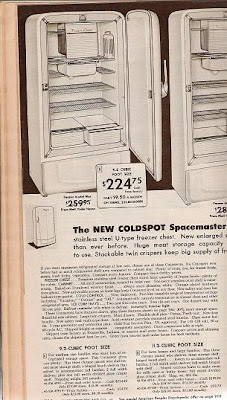Pictured below is a 9.2 cubic foot Sears Coldspot Spacemaster Refrigerator, available on sale in the 1949 Sears catalog for $224.75:
 The average hourly manufacturing wage in 1949 was $1.26, meaning that the average worker had to work for 178.4 hours (22.3 days or 4.5 weeks) in 1949 to earn enough money (before tax) to purchase the refrigerator.
The average hourly manufacturing wage in 1949 was $1.26, meaning that the average worker had to work for 178.4 hours (22.3 days or 4.5 weeks) in 1949 to earn enough money (before tax) to purchase the refrigerator.Pictured below is a current Sears model 9.5 cubic feet refrigerator, available on sale for $339.99. At the current average hourly manufacturing wage of $18.03, the average worker would have to work today for only 18.9 hours (only 2.4 days) to purchase the refrigerator.
 The difference in hours worked to purchase a 9 cu. foot (approx.) Sears refrigerator in the two years is displayed graphically below:
The difference in hours worked to purchase a 9 cu. foot (approx.) Sears refrigerator in the two years is displayed graphically below:  Bottom Line: We hear a lot of comparisons of today's economic conditions to the 1930s and the Great Depression, as if we're about to slip back to the living conditions of the 1930s and enter Great Depression II. Hopefully some of these comparisons will serve as an antidote to all of the daily gloom and doom.
Bottom Line: We hear a lot of comparisons of today's economic conditions to the 1930s and the Great Depression, as if we're about to slip back to the living conditions of the 1930s and enter Great Depression II. Hopefully some of these comparisons will serve as an antidote to all of the daily gloom and doom. A comparison of the price of a typical household appliance in 1949 (178.4 hours of work to purchase a refrigerator) to the price today (only 18.9 hours of work) is just one of hundreds of examples that demonstrate the significant increase in the average American's standard of living over time.
If consumers were paying the same price for a refrigerator today as consumers did in 1949 (178.4 hours of work at the average wage), the retail price today would be about $3,200 for a basic 9.5 cubic feet refrigerator (178.4 hours X $18.03 per hour). For a more deluxe Sears model refrigerator (retail price of $1,757 or 5.2 times more expensive than the basic model), the cost today would be about $17,000.
Despite the current economic slowdown, consumers have never had it so good. Ever. Anywhere.






No comments:
Post a Comment